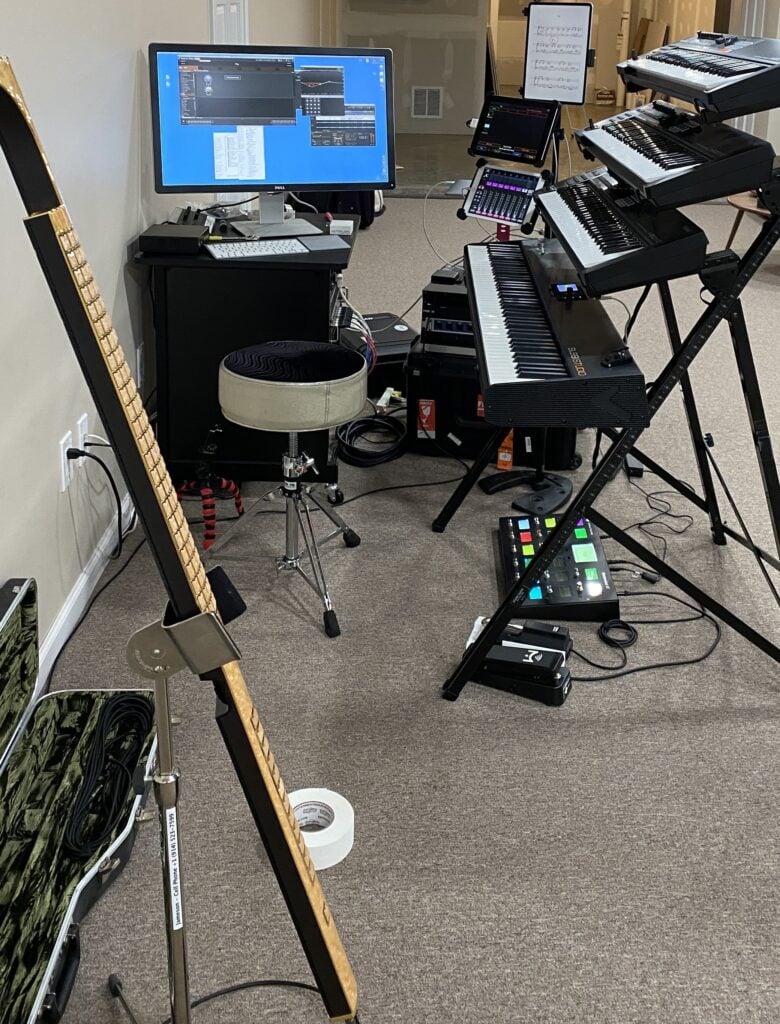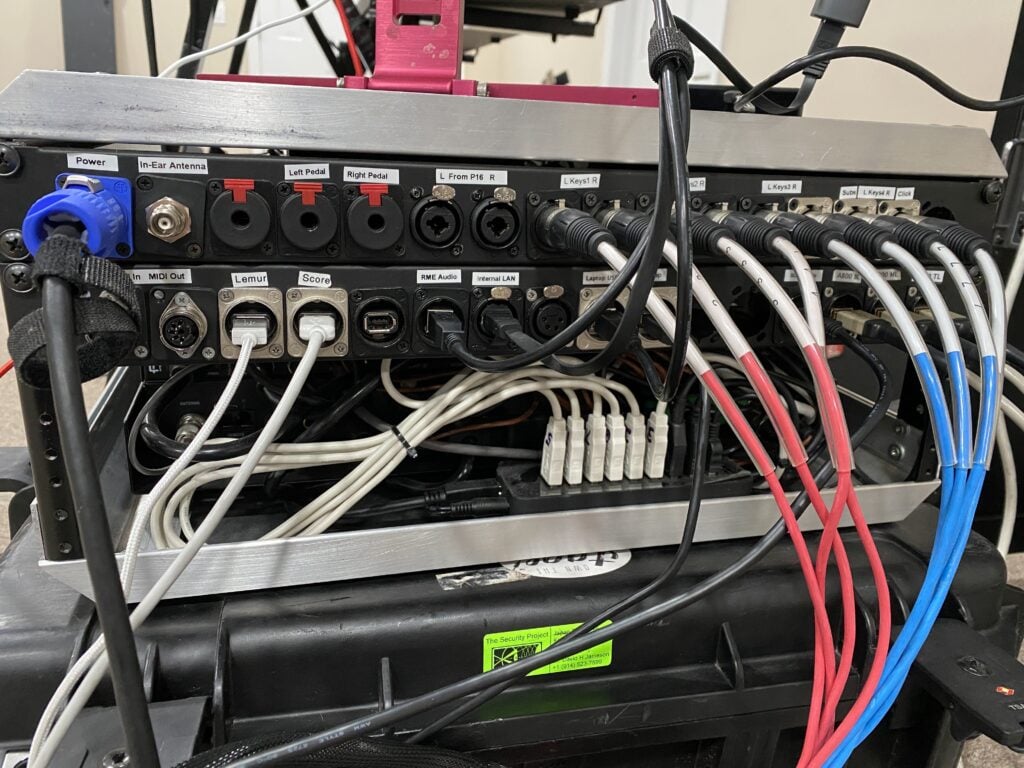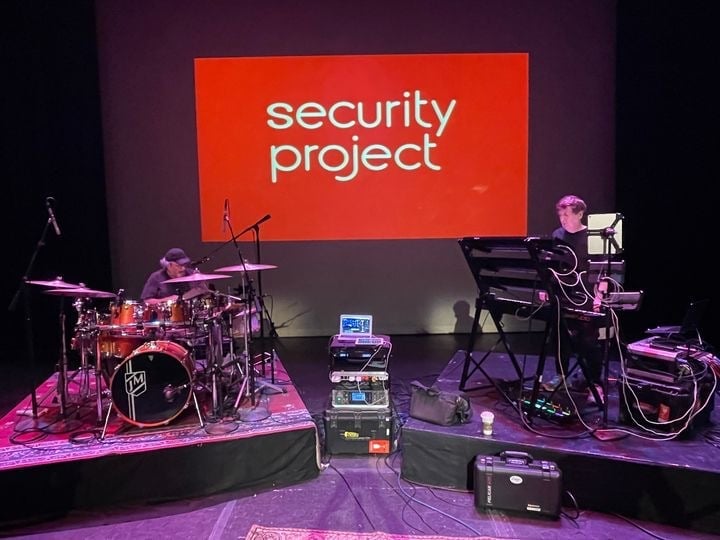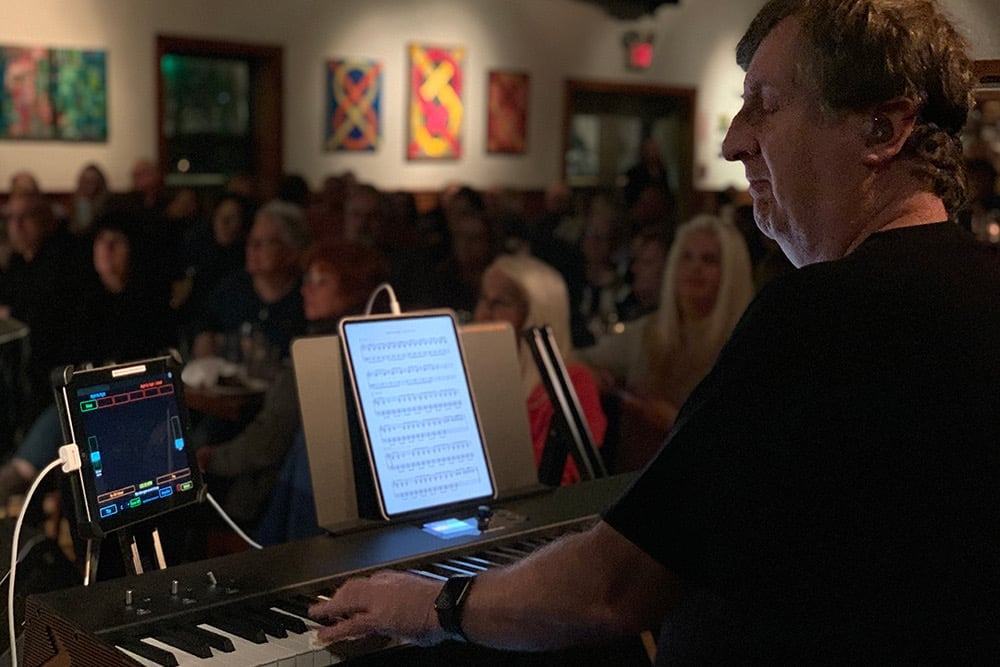I (David) have often been asked to describe my live keyboard rig which I use with the three bands in which I play:
.
Keyboards
.
I have four keyboard controllers:
- Studio Logic SL88 (88 notes weighted)
- Roland A800 PRO (61-note light weight, three of)
.
All four use USB connections and are connected to a back panel of a small 19” rack. See second image below. Through there, they connect to one of several USB-powered hubs. I use all four keyboards with Security Project and Beyond the Wall and I use the SL88 and one A800 Pro with Reelin’ In The Years.
Pedalboard
.
The MIDI pedal controller is an RJM GT Mastermind. A sustain pedal and an expression pedal are plugged in into it. The pedal controller is connected via USB to a powered hub. Gig Performer can send SysEx messages to the Mastermind automatically to change the button text labels as needed for each song part. That happens automatically when Gig Performer switches to specific songs. Other buttons on the pedalboard (and the sustain and expression pedals) control widgets in Gig Performer with the labels changing automatically so I can easily see which button to press for a particular option.
Rack
.
The 19” rack contains:
- RME UFX audio interface: I send 8 channels of audio to FOH, typically 3 stereo channels, a sub channel (for such things as Taurus bass type sounds) and a click track, which is only heard by other band members and only used when a song includes loops that can be turned on and off during the song thereby allowing the musicians to stay synced to the loops.
- WiFi router: the laptop connects via an ethernet cable and the top two iPads connect to the laptop via WiFi. Occasionally I will also have an iPhone connected to trigger various sounds remotely.
- Eigenharp interface: for when I use the Eigenharp, for example here and here.
- Furman power conditioner.
.
iPads.
.
The top iPad runs forScore for my sheet music and also selects the appropriate song in Gig Performer by sending a Program Change message to it when I select a song on the iPad. Two of the “drumpad” button on each Roland A800 are used to page the sheet music forward or backwards and one button on the pedalboard is also used to page forward.
The middle iPad is running Lemur with a template I developed specifically for Gig Performer and is used to give me remote bidirectional control of Gig Performer widgets (and therefore plugin parameters) as needed.
I use the bottom iPad is to manage my personal mix.
Edit: August 2023 —- I no longer use forScore. I have switched to MobileSheets which I have found to be far more suitable for technology users than was forScore, which seems more targeted the classical music world.
Laptop
.
- Apple MacBook Pro (2018, Intel) with 16Gb RAM (NB, the large monitor is used in my home studio but does not travel to gigs)
- The laptop is (obviously) running Gig Performer. Among many other features, this gives me instant glitch-free switching, even in the middle of a beat and patch persist. Although rarely needed, I can run Ableton Live alongside using OSC messages to control it from Gig Performer, allowing me to do such things as trigger clips from Gig Performer widgets. Gig Performer also has built-in support for Ableton Link so tempo synchronization between the two programs is trivial. For more on this, see the recent live stream with one of our customers who uses Gig Performer and Live together quite extensively.
- Many of the features in Gig Performer were driven directly by my experience touring with these bands. Other features come from interactions with other Gig Performer users on our community forums.
.
Plugins
.
While I obviously have a lot of plugins for testing purposes, the following are the main ones that I use with my bands:
- Acoustic piano – Pianoteq
- Rhodes/Wurly – Lounge Lizard
- Clav – Pianoteq (an optional add-on)
- Mellotron – MTron-Pro
- Hammond organ – Blue3
- Basic subtractive synths – The Legend, Oddity, Repro-1/5
- Marimba, Mallets, Vibes, etc. – Chromaphone
- Electric and acoustic guitars – various plugins from Musiclab
- Audio harmonizer – Pitchometry
- Effects – TH-U (Overloud)
- EQ – EQuilibrium
- Strings, choir, Horns etc. – Kontakt
.
I also leverage many of the plugins from the Arturia Modeling Collection and from Native Instruments

The large computer screen does not travel with me!
… 
This is the back of my 19” rack that contains my audio interface, in-ear transmitter, WiFi router, etc.

On tour with The Security Project, May 2022

Performing with Reelin’ in the Years
.
Related topics:
– Controlling the RJM GT Mastermind from Gig Performer
– Why we created Gig Performer
– My go-to plugin list
– David Jameson and Gig Performer in Action




